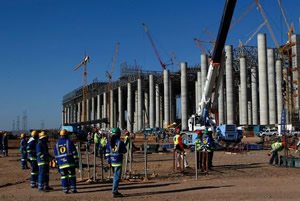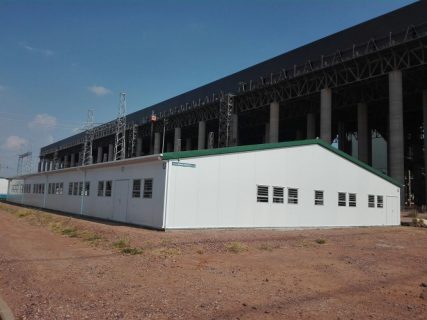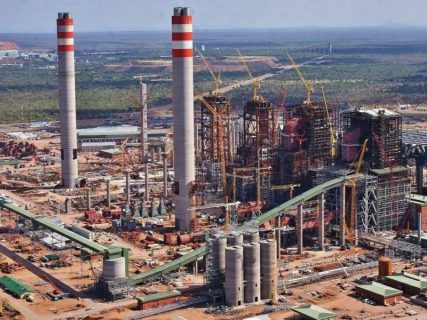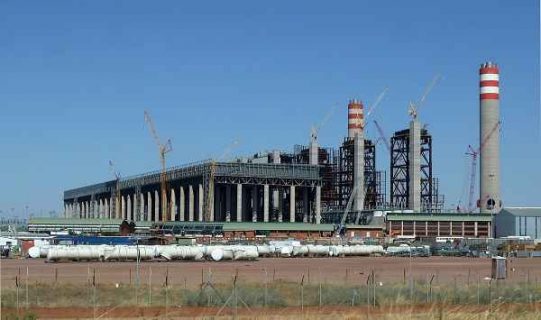The Medupi power plant, is located in Lephalale, Limpopo. It is a Greenfield coal-fired power plant comprising six units rated in total at 4764MW installed capacity. Upon completion, Medupi Power Station is set to be the largest dry-cooled power station in the world. The boiler and turbine contracts for Medupi are the largest contracts that Eskom has ever signed in its 90-year history. Below is the Medupi Power Project timeline and all you need to know about the project from beginning to the present date.
2007
Originally conceived as Project Alpha, with only three units planned to total 2400MW but the design was changed at a late stage and doubled in size. The boilers were envisaged to be supercritical in type, which would make them 38% more effective than other Eskom power stations.
Initial cost was around US $4bn but revised to around US $4.7bn.
Parsons Brinckerhoff was appointed as the project engineer to oversee all construction.
2008
First structural concrete poured and first three air-cooled condenser columns completed.
2009
Unit 6 boiler lift shaft completed.
2010
First structural steel erected at Unit 6 boiler, chimney South concrete slide completed to a height of 220m and chimney North concrete slide completed to a height of 220m.
2011
Chimney South first flue cans lined with borosilicate glass installed, upgrade of D1675 access road completed, 10 000 ton coal silo completed and auxiliary boiler completed.
2012
Direct-current supplies energised and first 24-hour performance test of 5.4 km overland coal conveyor.
Also Read: Lagos-Kano SGR project timeline and what you need to know
2013 Eskom’s Medupi Power Station on Schedule
Unit 4 generator motor threaded into stator and wet run of submerged scraper conveyor conducted, readying boilers for first fire.

Medupi Power Station, a Greenfields coal-fired plant project located on the west of Lephalale, Limpopo Province, South Africa is currently under construction as part of Eskom’s new build programme set to address the electricity demand and supply challenges facing the country.
The Greenfields coal plant project will comprise of six units with a gross nominal capacity of 800MW each , resulting in a total capacity of 4,800MW. The power plant utilises a super critical boiler and turbines, technology designed to operate at higher temperature and pressures than Eskom’s previous generation units for greater efficiency.
Medupi power station has been designed as a an environmentally friendly project as it utilises supercritical technology, direct dry cooling technology, flue gas desulphurisation, pulse jet fabric filters and low NOx burners, water and air pollution, air cooled condensers, and fauna and flora.
Since the plant will utilise the supercritical technology to improve the plant efficiency, the higher efficiency of supercritical boilers as designed for significantly higher steam temperatures and pressures resulting in better use of natural resources. It will result in burning less coal per megawatt leading to emission of less carbon dioxide and other gases into the atmosphere.
The plant also makes use of direct dry cooling technology which releases virtually no cooling water into the atmosphere providing a significant benefit in terms of water consumption. The power station is earmarked to use approximately 0.16 litres of water per kWh of electricity produced and this is expected to increase by 0.2 litres of water per kWh when the flue gas desulphurisation (FGD) plant is retrofitted to Medupi.
The project will also entail a Flue gas desulphurisation (FGD) as a retrofit and thus making it one of the environmental friendly coal-fired power stations. It will also include pulse jet fabric filters and low NOx burners. The low NOx burners on its boilers are designed to minimise the production of nitrogen oxides in the furnace.
The plant is designed in a manner that seeks to mitigate air as well as ground water pollution and this will be achieved through the lining of the coal stockyard and ash dumps, enclosed mill bins and fully enclosed transfer houses with dust extraction systems.
In addition, the law grade steam exhausted from the low pressure turbines and temperature is sent to the air cooled condenser and is then pumped through the feed water heaters back to the boiler to start the cycle over again. The essential part of using this system is on condensing the steam in order to pump the water back to the boiler for reuse.
Since the project is constructed on an 883 hactare farm which was previously used for game and cattle grazing, a thorough nature conservation exercise had to be effected to preserve endangered species. Indigenous trees, snakes, birds, animals were relocated, and for instance trees were replanted at a special nursery at the adjacent Matimba Power Station. In preserving the fauna onsite, the project put in place measures such as animal crossovers on the overland coal conveyor system to allow for the free movement.
The project which commenced in 2007 has invested approximately R2.3 billion (US$201.4million) in infrastructure development in the Lephalale area and has seen the construction of 995 houses and buying of 321 houses, and building of a new pre-school, supply of medical equipment to the surrounding clinics, upgrading of the electricity infrastructure, construction of the Paarl sewerage treatment plant with R11.5 million (US$1.1million) spent on upgrading of the initial 2.2 km of the D1675 road leading to the site.
Eskom has continued to invest in the community and together with Exxaro they will spend more than R150 million (US$15.0million) in upgrading and repairing Nelson Mandela road as well as tarring Kuipersbult road.
The project has improved the lives of many in the region as 17,000 people have been employed at peak with 650 set to be employed permanently upon completion of the project.
The development, with an estimated budget of R98.9 billion (US$10billion) excluding interest during construction but including escalation and transmission integration costs, is set reach R125.5 billion (US$12.5billion) to complete. Recently, Escom revised the date the first of the six units of the plant are set for synchronisation from end of 2013 to the second half of 2014 with each of the remaining five units to be synchronised at approximately eight month intervals.
Once complete, the project will make use of the coal that will be delivered from Grootegeluk mine through an overland conveyor system to the Medupi coal stockyard. The conveyor as the sole supply line will supply 10,000 tons of coal.
2014 Site integration test on Medupi Power Station in South Africa is complete
Overland ash conveyor commissioned.
Alstom has announced that it has successfully completed site integration test (SIT) on the Medupi power station in Limpopo. This means that the Medupi Power Station is ready for synchronization by December. Alstom was contracted by Eskom for the project.
The test validated and established that the Distributed Control Systems installed by Alstom were ready for performance. These systems were also ready for the First Fire and Integration. The test played a key role in ascertaining the safe operation of the plant. The new 6x800MW coal-fired power station/plant’s first unit (Unit 6) located near Lephalale in the Limpopo province is now ready for commissioning.
Some of the things included in the whole site integration testing process were over 100 tests and inspections were carried out upon installation of the system at the site. The company had completed working on the 70, 000 hardwired inputs/outputs on 5th of last month. Tests for the Medupi Power Station also involved the connection of the Local Area Network (LAN) to the Control Room workstation. DCS ability of the system to carry out fault finding was also tested.
DCS system and subsystem interfaces, and redundancies were also verified during the testing. Database access by a personal computer of Eskom was also part of the process.
According to the Medupi Power Station Project Director of Alstom Rafael Alvarez, the test was a team effort by personnel from South Africa, France, India, Philippines, Poland, UK, Ukrain, Malaysia and Egypt. It demonstrated Alstom’s expertise in Control and Instrumentation technology.
The plant also makes use of direct dry cooling technology which releases virtually no cooling water into the atmosphere providing a significant benefit in terms of water consumption.
2015
The first unit, no 6 turbine started running at optimal speed of 3000 revolutions per minute.
2016
No 5 turbine undergoes load testing, primary Coal stockyard and conveyor and Ngwedi substation transformer commissioned (part of Medupi Power Station Integration Project).
2017 Unit 5 of Medupi Power Station attains commercial operation status
Unit 4 was commissioned and Commercial operation for no 5 turbine begins.
South African state-owned utility, Eskom, humbly announced that Unit 5 at its Medupi Power Station Project in Lephalale, Limpopo, has finally achieved commercial operation status.
Also read:Eskom appoints new Medupi project director
Operating ahead of plan, the utility said the unit was formally confirmed commercial after the completion of control performance and the 72-hour dependability tests, putting all performance warranties to effect.
The parastatal remarked: “Unit 5 was first synchronised to the national grid on 8 September 2016.
“This was then ensued by additional analysis and optimising which lead to its complete power of 800MW being accomplished on 17 December 2016.” Adding that this breakthrough came ahead of the planned timeline of March 2018.”
With a production of 800MW going to the national grid, Unit 5 joined its sister unit, Unit 6, which has been adding to the balancing of electricity supply and demand since 23 August 2015. The notable progress came after rigorous unremitting testing goings-on and shared devotion from Eskom and its implementation partners.
Matshela Koko, interim group chief executive, said: “The Eskom new build programme is intended for reinforcing the electricity supply, Medupi with its second unit coming online, is a reflection of the undertakings towards realising this enterprise, Eskom congratulates the Medupi team, this breakthrough is certainly an embodiment of delivery.”
Commercial operation status guarantees technical compliance to statutory, safety and legal requirements.
This signatory breakthrough marks the contractual conferral of the unit from the primary contractors to Eskom, which means that Medupi Unit 5 is now part of the Eskom Generation fleet.
The African Development Bank loaned $500 million for the project in 2008. In 2010, the World Bank granted to loan South Africa $3.75 billion to help with numerous energy projects, with $3.05 billion allotted for completion of the Medupi power station.
The consent of the World Bank loan drew disapproval for supporting increased global emissions of greenhouse gases
2017 Kwikspace boosts timely delivery of Medupi Power Station
Once operational, Medupi Power Station – currently under construction near Lephalale in Limpopo Province – will be the largest dry cooled, coal fired power plant in the world. To assist in its development, Kwikspace Modular Buildings recently provided a 1 000 m2 dining hall to the facility.
Modular components for the new building, including 40mm thick Chromadek wall panels, aluminium windows and a light steel frame roof structure with a suspended ceiling, were manufactured in one of Kwikspace’s specialist factories and then transported to Medupi for rapid on-site assembly.
Comments Con De Villiers: “The use of modular technology enabled us to complete construction of Dining Dall D in just 25 working days, which was one day ahead of schedule. On-time delivery of the new power station is a critical requirement and we were pleased to assist our client in adhering to their stringent project deadline.”
Following completion, scheduled for 2019, Medupi will have a planned operational life of 50 years and will form part of Eskom’s integrated strategic electricity plan. The base load power generating plant will comprise of six 794 MW units, with a 4 800 MW installed capacity.
Kwikspace Modular Buildings can be contacted on +27 11 617 8000, www.kwikspace.co.za
2018 South Africa adds unit 2 of Medupi Power Station to the national grid
Unit 3 enters commercial operation and Unit 2 gets synchronised.
South Africa state-owned power utility Eskom has successfully synchronized unit 2 of the Medupi Power Station, set to be the largest dry-cooled power station in the world once complete to the national power grid eight months ahead of schedule.
Eskom’s group executive for group capital, Abram Masango confirmed the report and said, the unit was loaded to 400MW, making it the fifth of the six Medupi units to be synchronised to the national grid.
“The achievement of Unit 2 first synchronisation, marks a key milestone towards the full commercial operation of the unit. Lessons learnt on previous units were implemented on Unit 2, leading to the swiftness in delivering first power,” said Mr. Abram.
Also read: Another look at South Africa’s electricity generating options
Medupi Power Station
The plant which will also be the fourth largest coal-fired power plant, is located in Lephalale, Limpopo. It is a greenfield coal-fired power plant comprising six units rated in total at 4,764MW installed capacity. It will be able to meet the electricity needs of 3.5 million households in the country.
The first unit of the coal power station, near Lephalale Limpopo, went online and into operation in August 2015.
The synchronization of the unit, which is when the generator in the unit is, for the first time, electrically connected to the national power grid so that it is aligned with all other generators on the grid, was reached ahead of the June 2019 schedule.
Medupi Acting Project Director Zandi Shange said the next step will be the testing and optimisation of the unit, resulting in the unit being able to generate full power of 794MW of electricity feeding into the national grid for the country’s consumption.
Eskom explained in a statement that during this testing and optimisation phase, Unit 2 will be delivering power intermittently, thus contributing to the stability of the country’s electricity supply.
2019 South Africa adds unit 1 of Medupi Power Station to the national grid
Final unit achieved synchronisation.
South Africa’s state-owned power utility, Eskom has successfully synchronized unit 1 of the Medupi Power Station, set to be the largest dry-cooled power station in the world once complete to the national power grid.
Eskom COO Jan Oberholzer said that the first synchronization is a key milestone as the generation unit heads into commercial operation. The plan is to achieve commercial operation by November 2020.
“Delivering Unit 1 ahead of time is an indication that Team Medupi and its contractors are committed to deliver the project to the nation. This achievement signifies that Medupi is nearing its completion and is on track to reach commercialization by the end of 2020. Unit 1 at Medupi will eventually ramp up to full power of 800 MW,” said Oberholzer.
He further pointed out that the unit 1 is currently in the testing and optimization phase, which means that Unit 1 will deliver power intermittently for the time being and help bolster the grid. It is the last of its six new units at Medupi is generating coal-fired.
Also Read:Kenya to build a coal-fired power plant in Lamu
Medupi Power Station
The Medupi Power Station which will also be the fourth largest coal-fired power plant, is located in Lephalale, Limpopo. The project is part of the large-scale power delivery projects intended to support the grid system between the Limpopo and North West provinces.
The project is a greenfield coal-fired power plant comprising six units rated in total at 4,764MW installed capacity. It will be able to meet the electricity needs of 3.5 million households in the country. The US $13bn project, has already generated over 300 work opportunities, for which more than 100 persons have been hired from local communities.
2019 Unit 2 of Medupi power plant in South Africa attains commercial operation
Unit 2 of the Medupi power station in South Africa is now commercially operational. South Africa state-owned power utility Eskom revealed the report and said that the unit will be part of Eskom’s generating output, contributing just under 800MW to the South African power grid.
“Unit 2 joins its sister units 6,5,4, and 3 which have been in commercial operation contributing a total of 4,000MW to the national power grid respectively. This leaves one unit to be commercialised, unit 1, which was synchronised in August 2019 and is currently feeding an average of 400MW to the grid. The commercialisation of the unit is a ‘major milestone’ and signifies the imminent completion of the Medupi build project,” said Eskom’s Acting group chief executive Jabu Mabuza.
Also Read:AfDB decides not to fund Kenya’s coal-fired power plant project
Medupi power plant
The Medupi power plant, is located in Lephalale, Limpopo. It is a Greenfield coal-fired power plant comprising six units rated in total at 4764MW installed capacity. Originally conceived as Project Alpha in 2007, with only three units planned to total 2400MW, the design was changed at a late stage in 2007 and doubled in size. The boilers were envisaged to be supercritical in type, which would make them 38% more effective than other Eskom power stations.
It will be able to meet the electricity needs of 3.5 million households in the country. Commercial operation status ensures technical compliance to statutory, safety and legal requirements. This signatory milestone marks the contractual handover of the unit from the principal contractors under build project unit to its generation business. The first unit of the power station went online and into operation in 2015.
Upon completion, Medupi Power Station is set to be the largest dry-cooled power station in the world. The boiler and turbine contracts for Medupi are the largest contracts that Eskom has ever signed in its 90-year history. The planned operational life of the station is 50 years.
a attains commercial operation
2020 Eskom appoints new Medupi project director
South African energy giant Eskom on Monday appointed Phillip Dukashe to run Medupi power station.
Phillip Dukashe who has served Eskom for 22 years and brought Majuba back to its feet after the silo collapse is replacing Roman Crookes as Medupi’s project director with immediate effect.
Eskom CEO Brian Molefe told a radio station on Monday that Crookes who was set to leave at the end of January will do so with immediate effect.
Dukashe will now head up Eskom’s critical new build project which aims at introducing 4 800 MW of coal power into the country’s ailing grid.
Medupi’s first unit brought 800 MW onto the grid in 2015 after years of delay. The next unit is set to be completed in early 2017 with the overall project to be completed between 2019 and 2020.
Khulu Phasiwe, Eskom’s spokesperson said Dukashe has played a significant role in bringing Majuba power station back to operation in 2014 when a silo collapsed and dented its operations.
He added that Dukashe implemented a short-term solution to feed coal to the power station on a mobile feeder system while starting the process to rebuild the silo.
The silo collapse in November 2014 led to load shedding after its capacity was eroded from 3 600 MW to 1 400 MW.
Eskom has since used more than 1000 trucks for coal transportation and the new system reduced the number the number to 90 trucks with the new silo’s completion expected to end by 2017.
Dukashe is a civil engineer by profession and has worked for Eskom at various managerial levels.
He was the general manager for Generation Coal Projects from 2010 until. His work included major refurbishment of coal fired power stations such as return to service of the Komati, Camden and Grootvlei power stations.
He also had a role in the recovery of the Majuba silo and Duvha unit 3 projects. He also worked as power station manager for Tutuka power station between 2001 and 2005.
Eskom plans to either meet the deadlines set for Medupi project. We therefore want someone efficient enough to hit the ground running at Medupi, Phasiwe said.
Peripheral works such as overflow coal yards are undergoing expected to completed in 2021.
2021 Medupi Power Station in South Africa to be fully operational by end of year
In mid-May, South Africa’s Deputy President David Mabuza confirmed that the Medupi Power Station will be fully operational by end of the year. According to DP Mabuza, plans are afoot to make sure that there is enough electricity in the country. He further added that the government is planning to commercialise the power project.
In late June, Eskom assured parliament that all six units at Medupi Power Station are working and contributing to the national grid. Parliament’s Portfolio Committee Chairperson Khaya Magaxa said that construction of the power station is complete and all six units are operational. But the problem that is left now is around defects.
“Eskom is working on defects so that when they want to have any reparation somewhere it doesn’t contribute to the problem of load shedding, a process that they are promising us it could be done by the beginning of next year,” he said.
In early August, Eskom announced that Unit 1, the last of six generation units of the Medupi Power Station Project in Lephalale, attained commercial operation status and was thus handed over to the Generation division. This milestone marked the completion of all building activities on the 4 764MW project, which commenced in May 2007. The planned operational life of the station is 50 years.
Explosion
A few days later, there was a huge explosion at the power plant that led to significant damage that could take 2 years to repair. Several Eskom employees were suspended due to the explosion. The power company said that there was a deviation from procedure at one of its units, which led to the explosion.
“Following a preliminary investigation, it appears that while performing this activity, air was introduced into the generator at a point where hydrogen was still present in the generator at sufficient quantities to create an explosion which ignited and resulted in this explosion. It also appears that there was a deviation from procedure for carrying out his activity. As such, Eskom has undertaken to place those employees who were responsible to manage and execute this work under precautionary suspension pending the conclusion of the investigation,” said the company.
Mop-up operations were initiated in late August. According to Eskom spokesperson Sikhonathi Mantshantsha, the mop up operations form part of investigations. He also added that it is too early to talk about any disciplinary process for the suspended workers.
“As soon as the clearing of the debris is complete, the turbine will be open again. This is part of the investigation which will assess the damage and find conclusively what the cause of the explosive was. Once all that work is done they will then assess the damage and how long it will take and what it is that need to be replaced. It’s too early to talk about DC processes as we have stated previously, this will form part of the investigation,” he said.





so when will the whole plant be complete all contraction and commissioning?
I am Part of Team Medupi @ HV Yard.